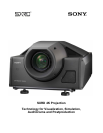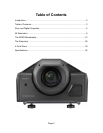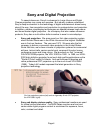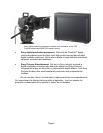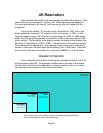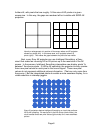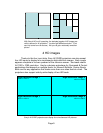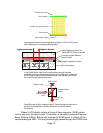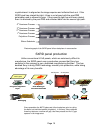Page 7
More visual information
If your business depends on rapid decision-making based on visual
information, it pays to make that information as clear and accessible as
technology will allow. That's why Command & Control and Visualization
customers have "edge blended" multiple projectors into a single image. This
incurred some sacrifice in real estate at the edges, as well as distracting shifts in
brightness and color. 4K SXRD projection represents a major advance.
Compared to edge blending, the 4K projection presents a giant canvas of 4096 x
2160 with no sacrifices. Third party vendors and system integrators have been
quick to use this pixel real estate to provide incredibly panoramic displays.
These can include multiple, configured-on-the-fly computer graphic windows,
each in its native resolution.
4K content, delivery and connection
4K content has originated from scanning 35mm or 65mm motion picture
film, from computer animation and from 4K digital cameras. For Digital Cinema,
this content is typically played from a growing selection of servers that are
compatible with the 4K signal.
The Sony 100 Series 4K projectors (SRX-S110, S105, R110 and R105)
have four input card slots, which can be configured to accept analog Y/Pb/Pr,
analog RGB, SD-SDI 4:2:2, HD-SDI 4:2:2, DC-SDI, dual link HD-SDI 4:4:4, dual
link DC-SDI and DVI inputs. A single standard definition video, high definition
video, computer RGB or 2K Digital Cinema source can be displayed across the
entire screen. Or four inputs can be displayed on four quadrants of the screen
simultaneously, a valuable feature for multi-point videoconferencing and multi-
part Sports Book display.
Superior presentation of HD content
Sony 4K SXRD projection enhances the display of HD and 2K sources,
making these projectors a smart choice even if you don't plan to show 4K content
in the immediate future. For audience members sitting close to the screen,
conventional HD projectors can reveal "jaggies"—unwanted pixel stair steps that
are particularly visible on hard-line picture edges, such as text and graphics.
Depending on microdisplay technology, conventional HD projectors can also
make the gaps between pixels readily visible on the screen. This unwanted
artifact is often called "screen door effect," because the picture appears to be
viewed through a screen door. Sony SXRD 4K projectors minimize both artifacts.
First, with SXRD the gaps between the pixels are unusually narrow in
proportion to the live image area. Roughly 92% of the image is live, with only
about 8% devoted to gaps. Then SXRD 4K projection presses this advantage



